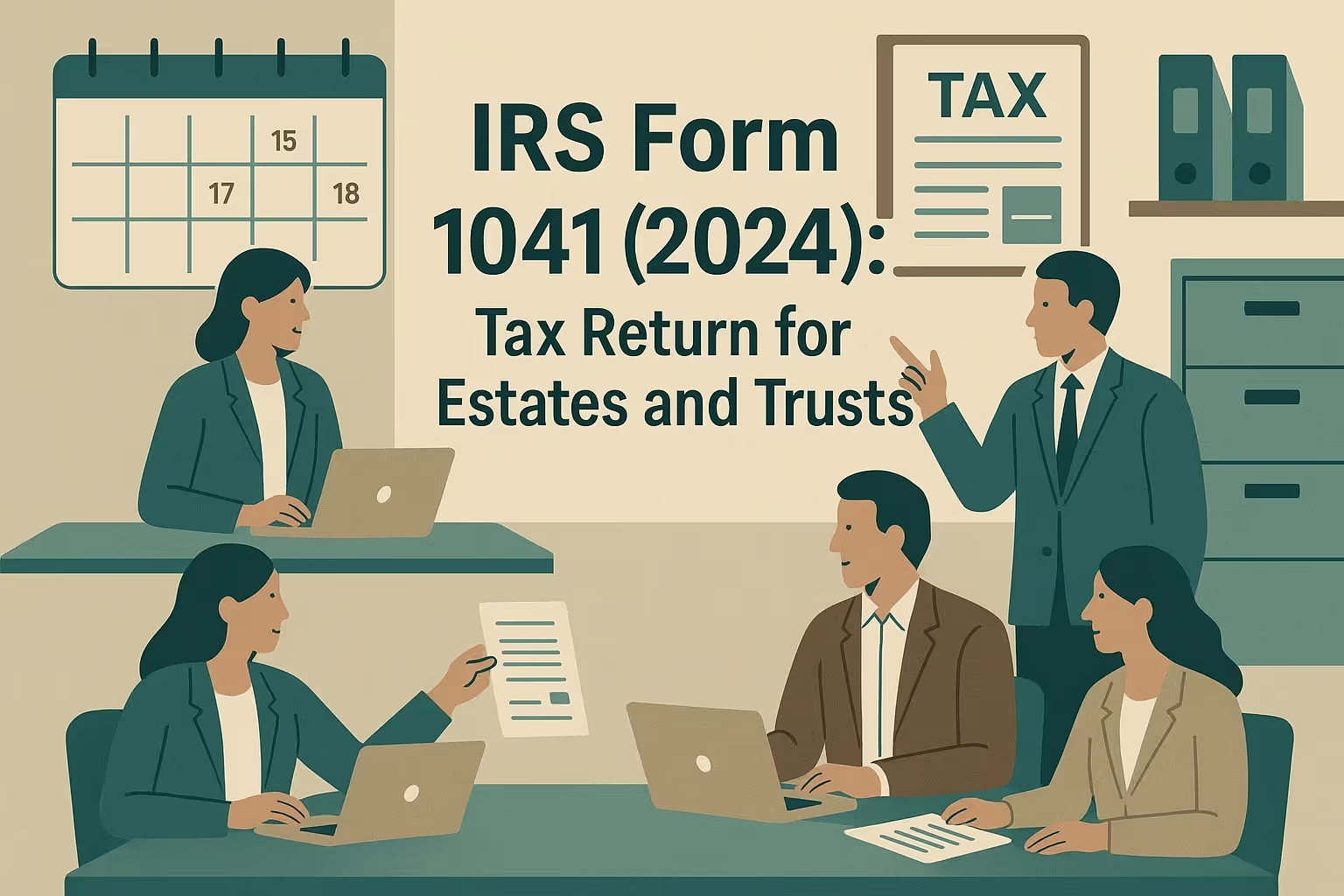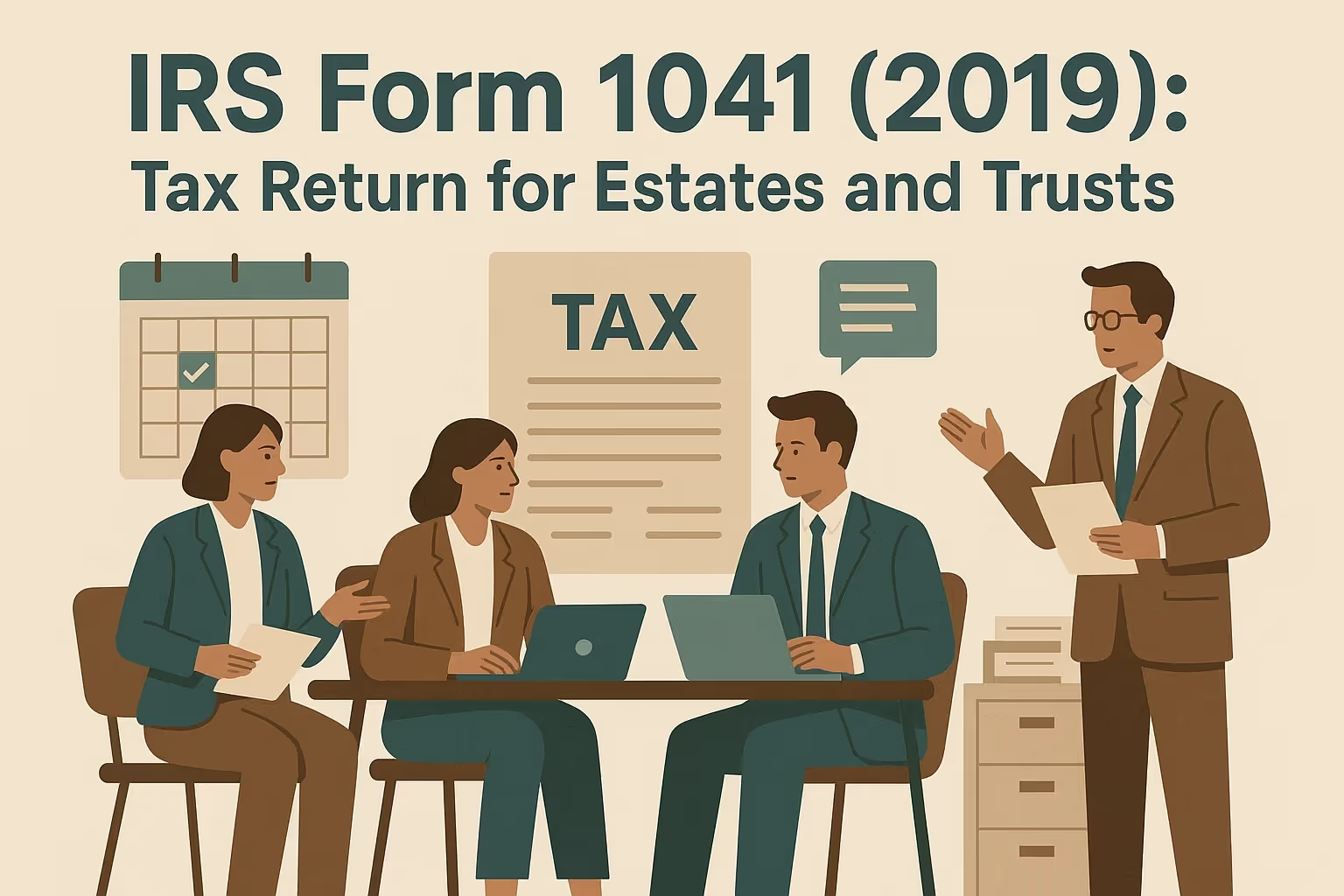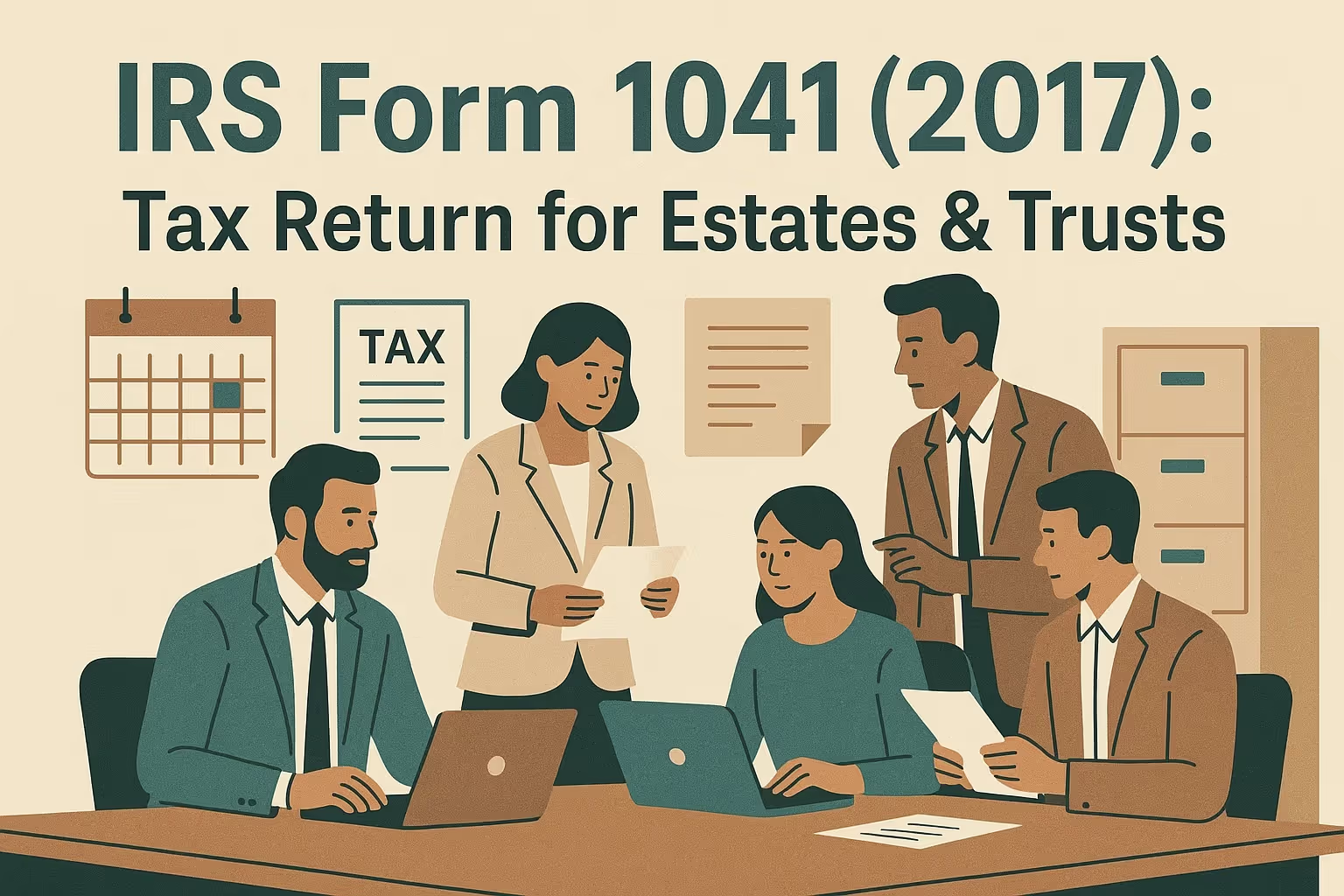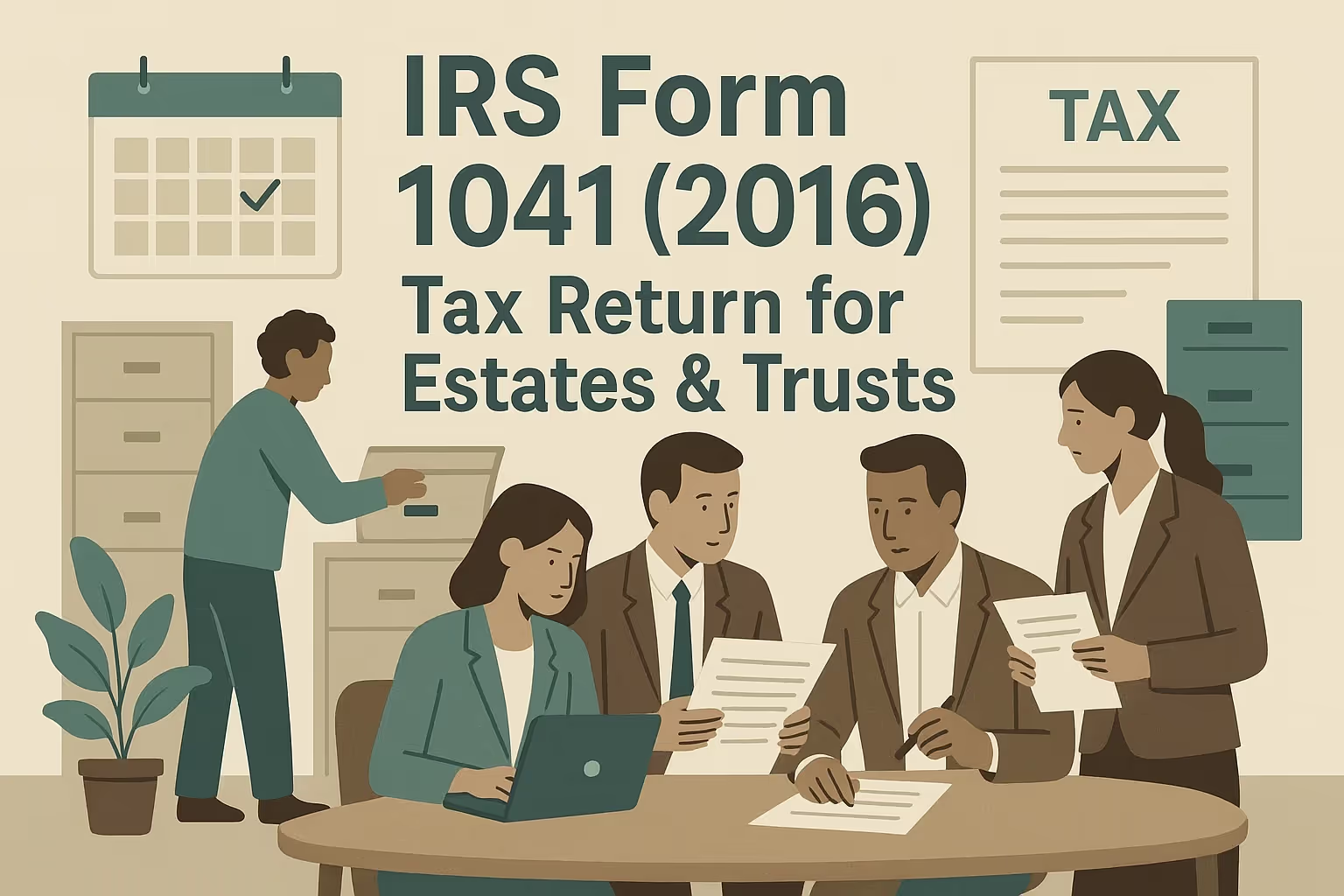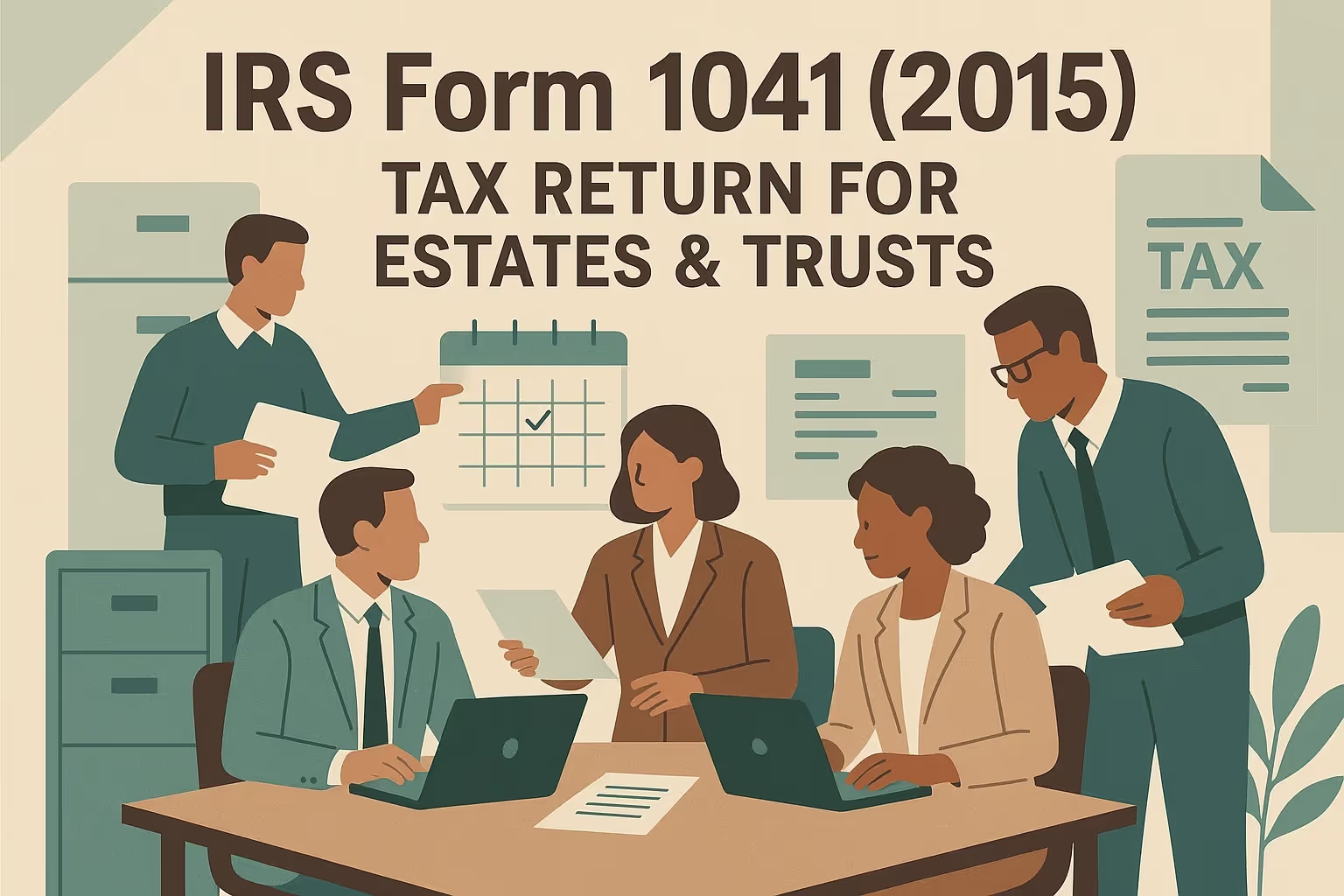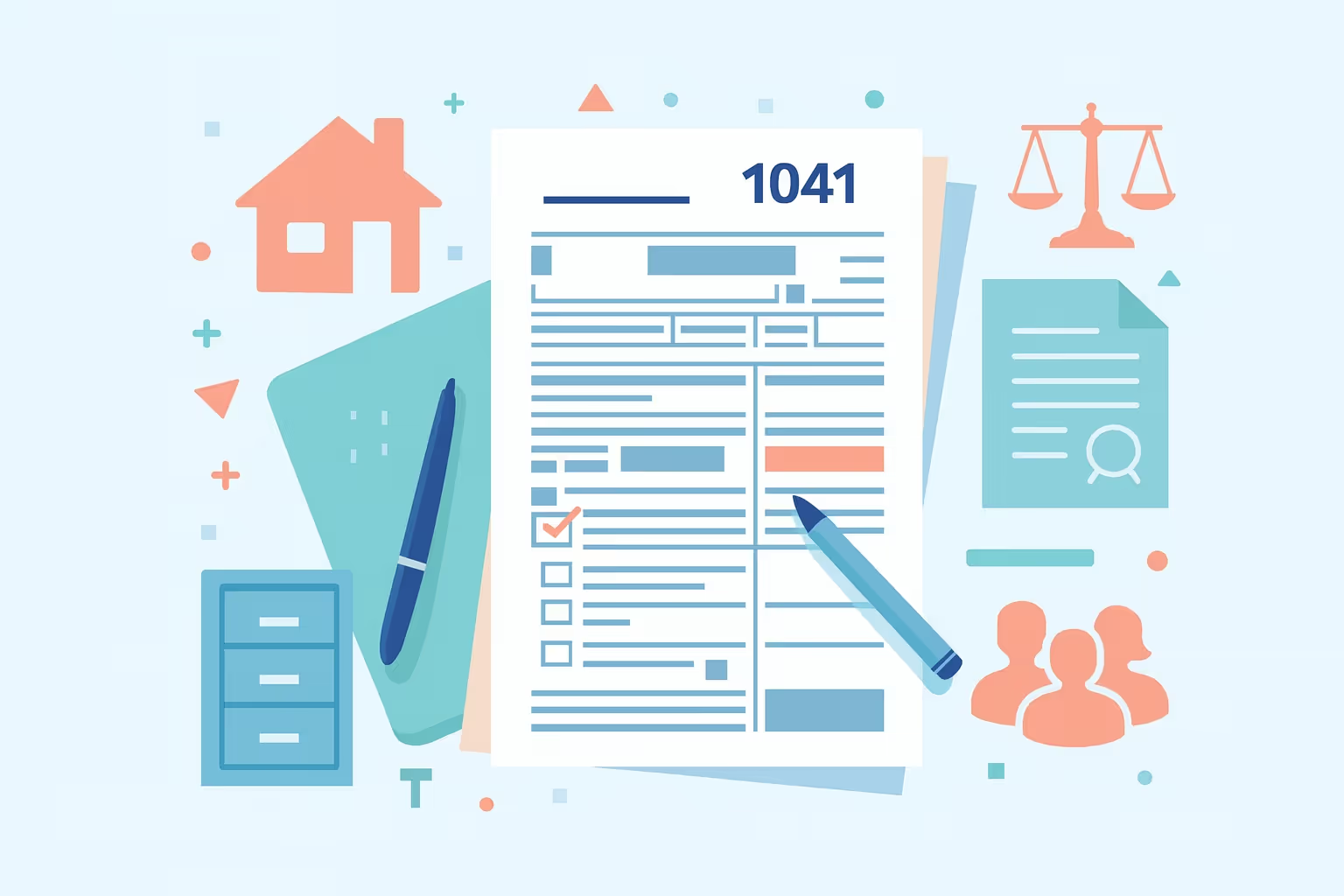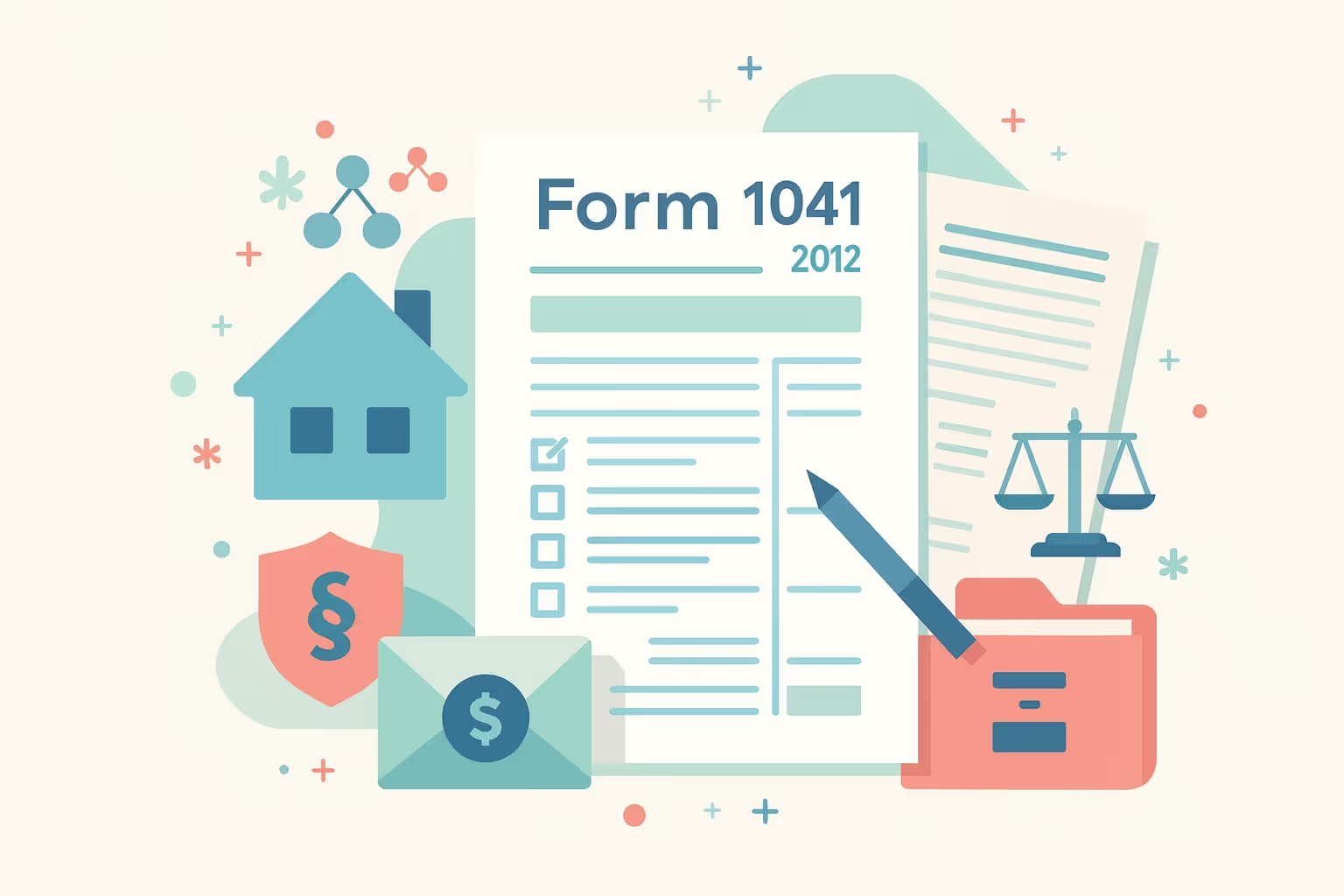Form 1041 2017 Instructions: Step-by-Step Filing Guide
Form 1041 is the official income tax return used by fiduciaries to report income, deductions, and taxes for estates and trusts. For the 2017 tax year, this form played a crucial role in ensuring that all income generated by an estate or trust—whether distributed to beneficiaries or retained for future distribution—was reported adequately for federal income tax purposes. Fiduciaries, such as executors or trustees, are responsible for accurately completing the filing process to determine the entity’s income tax liability under the Internal Revenue Code.
Filing requirements depend on various factors, including gross income, taxable income, and the type of entity involved. Estates and trusts, including simple trusts, complex trusts, and grantor trusts, may need to file Form 1041 if they earned a certain amount of income or had beneficiaries who are nonresident aliens. Because tax rules vary for each structure, fiduciaries must review the governing instrument or trust agreement to ensure compliance with specific tax purposes and filing obligations.
This guide explains the instructions for Form 1041 2017 in a clear, step-by-step format. It covers how to report all the income, determine deductions and credits, calculate tax imposed, and make necessary tax payments or estimated tax payments. Designed for beginners, it simplifies complex topics such as income distribution deduction, distributable net income, and capital gains while outlining each step required to file an accurate return.
Form 1041 at a Glance (2017) — What It Is & Who Must File?
Form 1041, U.S. Income Tax Return for Estates and Trusts, is the document fiduciaries use to report income, deductions, and tax payments for estates and trusts. It determines the amount of income tax owed based on the revenue generated, assets distributed, and other taxable events. The form also determines whether income is taxed to the entity or passed through to beneficiaries under federal income taxation rules.
1. Purpose of Form 1041
- This form serves as the annual income tax return for estates and trusts. It reports income, deductions, and credits to determine the total income tax liability for the tax year.
- Fiduciaries use it to report all the income received by the estate or trust, whether retained, distributed, or allocated for future distribution.
- It ensures compliance with the Internal Revenue Code and establishes the tax imposition on fiduciary entities.
2. Filing Requirements for 2017
Estates must file Form 1041 if any of the following apply:
- Gross income for the tax year is $600 or more.
- The estate has any beneficiary who is a nonresident alien.
Trusts must file Form 1041 if they meet any of these conditions:
- When they have any taxable income for the year.
- Gross income equals or exceeds $600, regardless of deductions.
- They have a nonresident alien beneficiary.
Bankruptcy estates file Form 1041 if gross income is $10,400 or more for 2017. These entities must report income and deductions separately from the debtor’s personal tax return.
3. Key Terms and Concepts
- Fiduciary: A person or entity, such as a trustee or executor, responsible for managing the estate or trust and ensuring accurate tax reporting.
- Beneficiaries: Individuals or organizations entitled to receive distributions from an estate or trust.
- Simple trust: A trust that must distribute all income currently and cannot make charitable contributions.
- Complex trust: A trust that can accumulate income, make charitable contributions, or distribute principal.
- Grantor trust: A type of trust where the grantor is treated as the owner for tax purposes, meaning income is reported on the grantor’s personal tax return.
4. Related Schedules and Forms
Fiduciaries often must attach additional schedules and forms when filing Form 1041:
- Schedule A: Reports charitable contributions permanently set aside for qualifying purposes.
- Schedule B: Calculates distributable net income and the income distribution deduction.
- Schedule D: Reports capital gains or losses from the sale of assets or property.
- Schedule K-1: Allocates income, deductions, and credits to each beneficiary for their own income tax return.
Form 1041 ensures that the income taxation of estates and trusts is handled correctly, preventing underpayment or double taxation. Fiduciaries should review the governing instrument or trust agreement before filing to confirm reporting requirements and deductions allowed under law.
What’s New for Tax Year 2017?
Several vital changes affected estates and trusts that filed Form 1041 for the 2017 tax year. These updates influenced due dates, tax rates, exemptions, and filing procedures. Fiduciaries should review these modifications carefully to ensure compliance and avoid errors in determining taxable income or making tax payments.
Filing Date Adjustment
The standard filing deadline for Form 1041 was extended to April 17, 2018. This change occurred because April 15 fell on a Sunday, and April 16 was a holiday in the District of Columbia, known as Emancipation Day. The extension applies to all estates and trusts following a calendar year schedule.
Updated Capital Gains Rates
For 2017, the tax rate on capital gains for estates and trusts was updated as follows:
- Up to $2,550: 0%
- $2,551 to $12,500: 15%
- Over $12,500: 20%
These thresholds are significantly lower than individual taxpayer limits, so fiduciaries must apply the correct rate when calculating tax imposed on gains.
Increased Thresholds and Exemptions
- The bankruptcy estate filing threshold increased to $10,400 in gross income.
- Qualified disability trusts could claim an exemption of up to $4,050, though the exemption phased out for higher modified adjusted gross income.
E-File and Administrative Updates
- Form 8879-F could only be associated with one Form 1041 return starting in 2017.
- Estates and trusts in Georgia, Illinois, Kentucky, Michigan, Tennessee, and Wisconsin had updated IRS mailing addresses.
- A new Schedule K-1 Code Z was introduced for reporting employee retention credits for areas impacted by hurricanes and wildfires.
These revisions simplified specific filing processes but required closer attention to details such as new codes, rates, and administrative rules. Reviewing the 2017 IRS instructions before filing helps fiduciaries ensure all the income, deductions, and credits are accurately reported.
Before You Start — Information, IDs, and Setup
Proper preparation helps fiduciaries complete the filing process efficiently. Gathering essential details before beginning Form 1041 prevents delays and ensures accurate reporting of income, deductions, and taxable events for the 2017 tax year.
Information Checklist
Fiduciaries should collect the following details:
- The legal name of the estate or trust and its Employer Identification Number (EIN).
- The fiduciary’s full name, title, and mailing address.
- The date the entity was created and its accounting method.
- All income records, including interest, dividends, rents, and proceeds from the sale of property.
- Expense and deduction documentation, such as legal fees, trustee fees, and charitable contributions.
- Distribution records show the amounts distributed to each beneficiary.
- Prior-year income tax return, if available, for comparison or carryover information.
Determining Entity Type
The fiduciary must determine the correct type of entity before filing:
- Decedent’s estate: Created after a person’s death to manage and distribute assets.
- Simple trust: Must distribute all income currently and cannot make charitable contributions.
- Complex trust: Can accumulate income, make charitable contributions, or distribute principal.
- Grantor trust: Income is reported on the grantor’s personal tax return for tax purposes.
- Qualified disability trust: Receives special exemption treatment under the Internal Revenue Code.
- Bankruptcy estate: A separate taxable entity created during bankruptcy proceedings.
Tax Year and Accounting Method
The fiduciary must select the appropriate tax year—calendar or fiscal—and maintain consistent accounting practices. Using the same method throughout ensures accuracy when calculating gross income, deductions, and tax imposed for future distributions.
Collecting this information before completing Form 1041 streamlines the process and minimizes filing errors. It also provides a solid foundation for calculating distributable net income, determining income tax liability, and reporting all required financial activities.
Step-by-Step: Completing Form 1041
Completing Form 1041 requires careful attention to each section, from entering basic entity information to calculating taxable income and reporting distributions. Fiduciaries should follow the steps below to ensure accuracy and compliance with 2017 filing requirements.
Section A and Entity Information
- Enter the estate or trust’s name, Employer Identification Number (EIN), and complete mailing address.
- Indicate the type of entity, such as a simple trust, complex trust, or decedent’s estate.
- Provide the date the entity was created and specify the accounting method used.
- Verify all entries match prior records and supporting documentation. Errors in identification can delay processing or result in the rejection of the income tax return.
Reporting Income (Lines 1–9)
- Report all sources of income, including interest, dividends, rents, royalties, and business proceeds.
- Include income generated from the sale of property or other assets.
- Separate qualified dividends and tax-exempt interest from other categories.
- Record capital gains or losses and attach Schedule D when applicable.
- Combine all amounts to calculate the total income for the tax year.
Reporting Deductions (Lines 10–16)
- Enter deductible expenses such as interest, taxes, fiduciary and trustee fees, and legal fees.
- Record allowable charitable contributions under Schedule A.
- Deduct administrative costs and specific professional fees associated with estate administration.
- Identify items subject to the 2% floor under section 67(e), such as investment advisory costs.
Computing Adjusted Total Income and Distributable Net Income
- Subtract total deductions from gross income to determine adjusted total income.
- Use Schedule B to calculate distributable net income and the income distribution deduction.
- Determine the amounts distributed to beneficiaries and verify that they match the totals reported on Schedule K-1.
- Confirm that the taxable portion of distributions is correctly allocated for tax purposes.
Computing the Tax
- Refer to Schedule G to calculate the total tax, including the regular income tax, alternative minimum tax, and any additional taxes imposed.
- Apply the correct tax rate based on the entity’s income level.
- Consider applicable credits that may reduce the total income tax liability.
Preparing Schedule K-1
- Complete a Schedule K-1 for each beneficiary, showing their share of income, deductions, and credits.
- Verify that the amounts distributed match figures reported on Schedule B.
- Provide copies of Schedule K-1 to each beneficiary by the due date of the return.
Fiduciaries should review all figures, verify mathematical accuracy, and attach required schedules before signing the return. A careful review ensures that the filing process is accurate and prevents penalties for incorrect or incomplete submissions.
Required Schedules and Attachments — What You Need and When
Fiduciaries often must include additional schedules and forms when filing Form 1041. These documents provide detailed reporting for deductions, income distribution, and tax computation.
Schedule A: Charitable Deductions
This schedule reports charitable contributions that are permanently set aside for qualifying purposes. It applies to complex trusts and estates that make philanthropic payments. The fiduciary should include documentation for contributions and verify eligibility under the Internal Revenue Code.
Schedule B: Income Distribution Deduction
This schedule calculates the distributable net income and determines the deductible amount distributed to beneficiaries. Fiduciaries must carefully compute the deduction to prevent overstatement or double-counting.
Schedule D: Capital Gains and Losses
Schedule D reports gains and losses from the sale or exchange of capital assets. It also applies when the estate or trust elects under section 643(e)(3) to treat gains as distributed.
Schedule G: Tax Computation
This schedule computes the total tax liability, including regular and additional taxes. Fiduciaries must use the correct tax rate table for estates and trusts.
Additional Attachments
Other required forms may include:
- Form 4797 is used to report the sale of business property.
- Form 8960 for Net Investment Income Tax when applicable.
- Form 1116 for claiming a Foreign Tax Credit.
- Statements supporting charitable contributions or estate tax deductions.
Including the appropriate schedules ensures that all deductions, credits, and income items are correctly reported. Fiduciaries should double-check attachments before submission to avoid delays in processing.
Filing Methods — E-File vs. Paper
Fiduciaries may file Form 1041 electronically or by paper, depending on preference and requirements. E-filing is generally faster and reduces errors, while paper filing may be necessary for complex returns or exceptional cases.
Electronic Filing (E-File)
- Use IRS-approved tax software or an authorized preparer.
- Complete the e-file signature process using Form 8453-FE or Form 8879-F.
- Ensure all required schedules and attachments are transmitted with the electronic return.
- Review acknowledgments from the IRS to confirm successful submission.
Paper Filing
- Print all completed forms, including required schedules and attachments.
- Mail the return to the appropriate IRS address based on the entity’s state.
- Use updated 2017 mailing addresses for Georgia, Illinois, Kentucky, Michigan, Tennessee, and Wisconsin.
- Include payment vouchers if paying by check or money order.
Filing Deadlines and Extensions
- The standard filing deadline for 2017 returns was April 17, 2018.
- Fiduciaries may file Form 7004 to request a 5½-month extension.
- An extension to the filing does not extend the time to pay tax owed.
Selecting the appropriate filing method ensures the fiduciary meets all legal obligations and avoids unnecessary penalties or delays.
Payments, Estimates, and Extensions
Fiduciaries must ensure all tax payments are made accurately and on time to prevent penalties and interest. Form 1041 offers several payment options, including electronic and paper methods, depending on the estate or trust's preference.
Making a Payment
- Payments may be made electronically through the IRS Direct Pay system, the Electronic Federal Tax Payment System (EFTPS), or by credit or debit card.
- When paying by check or money order, please make the payment payable to the United States Treasury. The estate or trust’s name, Employer Identification Number (EIN), and the phrase “2017 Form 1041” should appear on the payment.
- Fiduciaries using paper filing should include Form 1041-V and a payment voucher to ensure proper crediting of the payment.
Estimated Tax Payments
- Estates and trusts that expect to owe $1,000 or more in tax must make quarterly estimated tax payments using Form 1041-ES.
- Due dates for 2017 estimated payments were: April 17, June 15, September 15, 2017, and January 16, 2018.
- Failure to make sufficient estimated tax payments may result in penalties. Fiduciaries should base estimates on expected taxable income, deductions, and credits for the year.
Filing an Extension
- Fiduciaries who need more time to file may submit Form 7004, Application for Automatic Extension of Time to File Certain Business Income Tax, Information, and Other Returns.
- The extension period is 5½ months, moving the 2017 filing deadline to October 1, 2018.
- Filing an extension extends the time to file, not the time to pay. Any unpaid tax must be paid by the original due date to avoid interest and penalties.
Timely and accurate payments demonstrate compliance with the Internal Revenue Code and help avoid penalties associated with late or insufficient tax payments.
Common Errors and How to Avoid Them
Errors on Form 1041 can lead to processing delays, penalties, or additional correspondence from the IRS. Fiduciaries can mitigate these risks by carefully reviewing the return before submission.
Common Filing Errors
- Incorrect or missing Employer Identification Number (EIN).
- Mismatch between the entity name and EIN on file with the IRS.
- Selecting the wrong entity type, such as labeling a complex trust as a simple trust.
- Using outdated forms or mailing to an incorrect IRS address.
Income and Deduction Mistakes
- Failing to separate qualified dividends and tax-exempt interest when calculating gross income.
- Incorrectly reporting capital gains or omitting Schedule D when required.
- Errors in computing the distributable net income or the income distribution deduction.
- Omitting deductible expenses such as legal fees, trustee fees, or fiduciary fees associated with estate administration.
Schedule and Attachment Errors
- Missing Schedule K-1 forms or providing incorrect beneficiary information.
- Failing to match Schedule B totals with corresponding line items on Form 1041.
- Misreporting charitable contributions that are not permanently set aside or qualify under the governing instrument.
Prevention Strategies
- Review all mathematical calculations before filing.
- Verify all attachments and schedules are complete.
- Confirm that beneficiary totals reconcile with the distributable income reported.
- Ensure that all signatures, dates, and payment details are included.
Taking time to double-check information before submission helps fiduciaries meet filing obligations accurately and minimizes tax liability errors.
Special Situations and First-Time Filers
Certain fiduciaries face unique circumstances when filing Form 1041, such as managing dormant trusts, bankruptcy estates, or newly created entities. Understanding these special rules ensures proper compliance and accurate reporting.
Zero-Activity or Minimal-Income Entities
- A trust with gross income below $600 and no nonresident alien beneficiaries generally does not need to file.
- Even with minimal income, the fiduciary should review whether any tax liability or reporting requirement exists.
- Maintaining records during inactive years supports accurate filing in future periods.
Grantor Trusts
- Income from a grantor trust is typically reported on the grantor’s personal income tax return rather than Form 1041.
- The fiduciary may use one of two optional reporting methods if filing Form 1041 is still necessary for informational purposes.
- Fiduciaries should reference the trust agreement to determine the proper filing treatment for tax purposes defined by the Internal Revenue Code.
Bankruptcy Estates
- A bankruptcy estate must file Form 1041 if gross income exceeds the annual threshold for that tax year.
- The fiduciary should report income and deductions separately from the individual debtor’s tax return.
- All payments, proceeds, and deductions must be clearly allocated to avoid duplicate reporting.
First-Time Fiduciaries
- New fiduciaries should obtain an Employer Identification Number (EIN) before filing.
- Records of all income, deductions, and amounts distributed should be maintained throughout the tax year.
- Fiduciaries should consider consulting a professional for guidance on governing instruments, trust administration, and the allocation of taxable income.
Fiduciaries managing estates and trusts for the first time should remain diligent in maintaining accurate records and adhering to all reporting requirements. Proper compliance promotes transparency, reduces tax exposure, and ensures that beneficiaries receive the correct distributions in accordance with the law.
Frequently Asked Questions
What are the Form 1041 2017 instructions for estates and trusts?
The Form 1041 2017 instructions guide fiduciaries through reporting all the income, deductions, and credits for estates and trusts. They explain how to complete each section of the income tax return, determine taxable income, and calculate the total tax imposed. These instructions also outline the proper use of schedules for distributable net income, capital gains, and charitable contributions under the Internal Revenue Code.
How is taxable income calculated on Form 1041?
Taxable income for estates and trusts is calculated by subtracting allowable deductions, such as legal fees, trustee fees, and charitable contributions, from total gross income. Fiduciaries must include revenue generated from dividends, rents, property sales, and other proceeds. After applying credits and the income distribution deduction, the remaining balance determines the income tax liability for the tax year.
Do fiduciaries need to make estimated tax payments?
Yes, fiduciaries must make estimated tax payments if an estate or trust expects to owe $1,000 or more in tax for the year. These quarterly payments cover income taxation on income generated throughout the year and help reduce penalties. The filing process uses Form 1041-ES, which ensures accurate allocation of payments before filing the final income tax return.
What income is considered taxable for estates and trusts?
Taxable income includes interest, dividends, rents, gains from the sale of assets, and other income distributed or held for future distribution. Estates and trusts must also report tax-exempt interest for informational purposes. Whether the income is retained or distributed, fiduciaries must properly allocate it between beneficiaries and the entity to ensure correct reporting under federal tax purposes.
How do fiduciaries report capital gains and deductions?
Fiduciaries report capital gains on Schedule D of Form 1041, separating short-term and long-term gains from the sale of property or investments. Deductions such as legal fees, trustee fees, and expenses related to estate administration are included on the main form. For complex trust filings, fiduciaries must also report charitable deductions that are permanently set aside under the governing instrument or trust agreement.
What special rules apply to complex and straightforward trusts?
A simple trust must distribute all income currently and cannot make charitable contributions, while a complex trust may accumulate income, make contributions, or distribute principal. Both must calculate distributable net income to determine the income distribution deduction and the tax imposed. Grantor trusts and revocable trusts follow separate tax purposes defined under the Internal Revenue Code.
What happens if a bankruptcy estate files Form 1041 late?
If a bankruptcy estate files Form 1041 after the due date, it may face penalties and interest on the unpaid tax. The fiduciary remains responsible for ensuring all the income is reported and that tax payments are made promptly. Filing Form 7004 before the due date allows an automatic extension, but fiduciaries must still pay tax owed by the original filing date.






